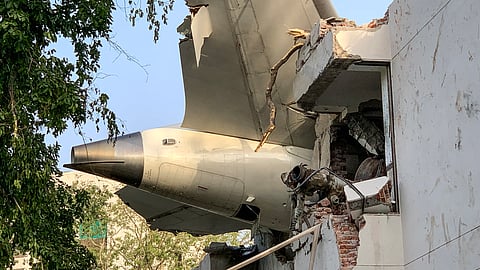

When will Indian aviation realise that safety is more important than commercial gains? The tragic loss of lives in the crash at Ahmedabad is a rude reminder of the aviation industry’s procrastination on several fronts.
The Directorate General of Civil Aviation (DGCA), along with National Transportation Safety Board of the US and Air Accident Investigation Board of the UK, will be involved in the investigation. The crucial digital flight data recorder and cockpit voice recorder will soon have been recovered intact from the crash site. The preliminary report should be out in less than a month if the DGCA follows international standards.
But the standards have not always been followed. The technical annexes developed by the International Civil Aviation Organization (ICAO), the specialised UN agency responsible for managing the Convention on International Civil Aviation, are applied universally and aimed at ensuring uniformity and safety. Annex 13, which pertains to accidents, clearly spells out the investigation standards. Even before the fire had subsided at the crash site in Ahmedabad, the DGCA issued a statement violating the protocol. One never discloses the names of the crew, but that was done.
The primary objective of an investigation is to identify the cause and take corrective measures to prevent recurrence. When you see the same kind of errors being the cause of a repeat accident, you know that our investigations have not achieved the objective. Take the number of tail strike accidents that have taken place in the past 3 years. This points to the poor training and safety standards of the airlines concerned, but the regulator, too, has failed to take proactive actions. We live in a system where one feels reports are watered down and accidents reported only as incidents to keep the slate clean for insurance criterions.
We have had aircraft going off the runway because of touching down at high speed and too late. The same airline has been involved in some accidents where lives were lost and some where the aircraft was written off. The failure of the media to highlight these is a cause of worry; negative publicity has more impact on the minds of travellers and pushes the system to be more proactive.
Most airports in India are surrounded by structures in violation of ICAO standards. When an accident takes place, access to the crashed aircraft should be easily available. This has been pointed out and flagged earlier. In the report on the Mangaluru crash of 2010, the court of inquiry report made false statements to say the rescue team arrived within 4 minutes. What they chose to hide was the fact that the fire tender never reached the aircraft, as it was bogged down outside the airport. Those aboard did not die during the crash; they burnt to death in their seats as the rescue reached too late.
Fatigue and rest are two other important factors for aviation safety. The regulator often tailors them more to suit airlines’ commercial requirements than for the safety of the crew and passengers. Fatigue and sleep deprivation have caused several accidents worldwide and several countries have implemented strict fatigue risk management systems. In India, we have a system on paper, but there is no proper monitoring done to ensure the airlines follow them. Premature deaths of pilots seem not to have woken the conscience of the regulator or the aviation ministry.
The accident in Ahmedabad should be a hard lesson for the civil aviation system in India. Do we sweep the lessons under the carpet or implement stricter safety norms? We need a transparent investigation in this case and independent media coverage on aviation safety in the long run. Investigative journalism is one of the needs of the hour to make our skies safer.
The rapid expansion of airlines with insufficient qualified professionals to man the cockpits, maintain aircraft and man air traffic control stations has to be addressed on a war footing. Over-dependence on automation has diluted manual flying skills. The training standards have to be raised to a much higher level. Safety monitoring has to be streamlined, and there should be no compromise on standards.
As far back as 2006, the ICAO had flagged the lack of an independent regulator in India. And in 2025 we continue to have the ministry calling the shots. After every accident, one hears a defence of the system in spite of blatant safety violations. We should have qualified professionals manning the regulator posts.
Public memory tends to be short. The media frenzy will soon subside and start again after the next fatal accident. Hopefully, the judiciary will wake up to the danger and come down hard on the people manning the controls at the ministry and the DGCA. Lives are always precious and the latest tragedy cannot be wished away. Efforts to make the Indian skies safer have to be addressed as a priority.
The accident investigation timeline laid down in ICAO’s Annex 13 must be strictly followed. People have the right to know if the skies are safe. At the moment, we are on a wing and prayer whenever we fly. Before we claim to have the fastest growing aviation system, we need to get our safety levels up.
Capt Mohan A Ranganathan is a retired airline instructor pilot and a former member of the Civil Aviation Safety Advisory Council
(Views are personal)